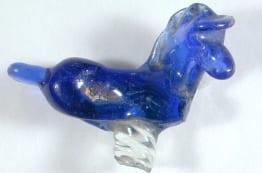Petrie’s Menagerie: The Horse
By Edmund Connolly, on 16 August 2013
Last week’s animals weren’t as exotic as their forerunners, and we will be looking at another recognisable animal for both Ancient Egyptians and Victorian Londoners. As promised, this week will be examining the horse, perhaps a not so obvious element of an Egypt based menagerie.
Petrie’s Menagerie #4 The Horse
Man’s best friend may be a dog, but man’s most useful friend is probably the horse and I won’t insult my readers by describing one.
“With the harnessing of its strength and swiftness to provide mobility, the horse transformed human existence”
Lawrence, 223.
The Object:
Horses were introduced into Egypt during the Second Intermediate Period (about 1700-1550 BC), with the Petrie laying claim to (potentially) the remains of the earliest African horse find of around 1675 BC[1] (Raulwing and Clutton-Brock, 2008, 2) (UC43392). The specimen appears to display signs of wear in the corners of the mouth, which may suggest wearing due to a bit (Raluwing and Clutton-Brock, 2008. 2; 25). There is much contention as to whether or not this is an early domestic horse find, or even if it is a horse at all[2].
Horses had a major role in warfare and played a prominent role in the Theban v. Hyksos wars. Both sides used horses, more predominantly for chariots, where a team of two was common practice. Later, Kush (a Sudanese site) became renowned for its good horses which were blessed with Royal mention by King Piy[3].
Aside from the warring background the horse I have picked comes from a far more docile past time: hair-curling.
This curler is made of bronze, with the small curling tong at the far end of the horse, beneath the outstretched front legs. Personally, I think it unlikely this piece actually functioned as a hair curler, the curling part seems far too small for any long locks; instead I think it is the galloping horse which is the main focal point. The horse could be a symbol of an elite, given the fancy plumage on its head it is clearly not a run of the mill specimen, but perhaps bedecked for a specific event or person.
Petrie’s Peers:
It is difficult to establish an absolute date for man working with horses, a 15,000 year old carving may depict a horsehead with bridle marks upon it has been discovered (Lawrence, 223); thus the equestrian-human relationship was well established prior to the 19th century. For both Ancient Egyptians and Victorians, riding on a horse had an element of the elite, be it of military or social standing. Sitting astride a horse gives a literal height, as well as a statement of wealth and social standing. Even today, the so called ‘Sport of Kings’[4], horse racing, has a global following, whilst fox hunting remains an elitist sport that denotes social hierarchy as well as an individual’s wealth (Lawrence, 225).
In Sewell’s Black Beauty (first published 1877) horses are used to represent different tracts of society, even adopting anthropomorphic qualities in a parable of pride and hardship. Horses clearly are a vehicle for human society to represent facets of their own identity, as well as a practical economic means. Any viewer would recognise this hair curler as horse, but would they see an elite symbol of Kingship, a companion, or a labourer for industrial and transport purposes?
The Menagerie:
I initially chose this piece purely for aesthetic reason, it is unquestionably beautiful and unlike many other bronzes within the collection. However, after a bit of light delving, it is evident horses are far more rooted in the human psyche that may be immediately apparent. Whilst it may be a somewhat commonplace animal, I think this horse with his ceremonial plumed head and athletic gallop has a well-deserved place in our Petrie Menagerie.
Next week we dive into the Nilotic depths to cavort with fish and dolphins, plus I am writing about the one creature on this planet of which I am scared[5].
 Edmund works at the Petrie Museum of Egyptian Archaeology as the Projects Coordinator. He graduated from the Institute of Archaeology, UCL, in 2012 and plays sport for UCL almuni and ULU.
Edmund works at the Petrie Museum of Egyptian Archaeology as the Projects Coordinator. He graduated from the Institute of Archaeology, UCL, in 2012 and plays sport for UCL almuni and ULU.
[1] The main skeleton is now in the Natural History Museum holdings.
[2] See: Raluwing and Clutton-Brock, The Buhen Horse: Fifty years on 1958-2008. Can be read here: http://booksandjournals.brillonline.com/content/10.1163/187416509×12492786609122
[4] I whole heartedly disagree with this onerous title
[5] It is not a spider, I have wanted a pet Goliath bird-eater spider called Sir Reginald since I was 6.
5 Responses to “Petrie’s Menagerie: The Horse”
- 1
-
2
Alan wrote on 5 August 2014:
Hi!
Very interesting article. When I was a kid my grandmother taught me many things about horses. I also remember, that she has had a great collection of horses made of glass, porcelain and wood. Unfortunately, I have no idea what have happened with all those beautiful things… -
3
Ammy wrote on 7 August 2014:
Imagine what would happened, if people haven’t found out, that they can ride a horse… I think that this discovery is as important as invention of circle. History would definitely be different without it.
Btw, sometimes I wonder if this discovery was good also for horses. Beautiful and so intelligent animals. Unfortunately, very people don’t treat them right. -
4
tom wrote on 26 August 2014:
“Btw, sometimes I wonder if this discovery was good also for horses. Beautiful and so intelligent animals. Unfortunately, very people don’t treat them right.”
I can say the same about dogs, cats and many other animals.
-
5
Katy wrote on 12 December 2019:
A good, easy-to-read article. I like people who have passion. And it doesn’t matter if they are horses, dogs or cats. The most sad is that horses are no longer treated as partners. This bad attitude towards animals unfortunately testifies to us people. It is comforting that more and more people are changing their approach.
 Close
Close





Today, I went to the beach front with my kids. I found a sea shell and gave
it to my 4 year old daughter and said “You can hear the ocean if you put this to your ear.” She placed
the shell to her ear and screamed. There was a hermit crab inside and it pinched
her ear. She never wants to go back! LoL I know this is
entirely off topic but I had to tell someone!